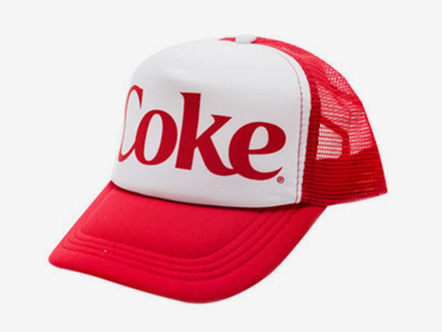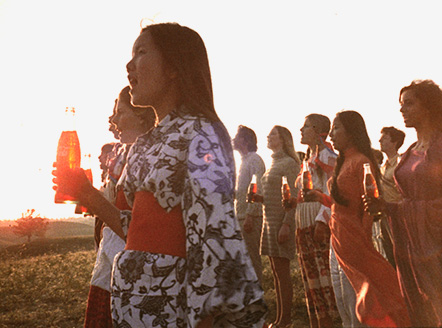The Narrowing Scope of the Recursive Image
October 16, 2017essay,
Our media-inscribed self-images direct not only the way in which we perceive ourselves, but on a cosmetic level, can normalize our attempts at differentiation. DAI participant Katja Dendulk unlocks this algorithmic process in her essay below as part of the Open! COOP Academy research theme (Against) Neuralgia: Care of the Brain in Times of Cognitive Capitalism. Does the scientifically proven phenomenon of our preference for novelty paradoxically swallow self-expression? How might our increasing awareness rejigger self-image under mass media?

In this article I do a relatively free speculative mapping of some components underlying cultural production today. The implementation of algorithms in cultural production has lead to an initial aesthetic funnelling of the produced works. I begin this line of inquiry by linking the peak shift phenomenon to our reception of aesthetic novelty and its implications in the cosmetic register, following the connection scientists have made between peak shift and our understanding of what is beautiful. In turn, this leads me to a few socio-economical implications regarding the construction of our social identities within our current political landscape and cognitive-cultural economy. I make a couple of assumptions in this text: first, that cosmetics is an intersubjective semiotic game and is inherently productive; second, that the concept of cosmetics and mass media are reciprocally tied to one another. I argue that this consequently forms an increasingly reiterative loop between cosmetics and mass media whose procedures and mechanisms are increasingly being remediated through the abstraction inherent to algorithmic procedure. As such this limits us to constructing our social identities necessary to navigate the life project,1 from prefabricated building blocks. I also look into the relation between algorithmic data inquiry and privacy intrusion.
A cognitive phenomenon within comparative psychology and behavioural ecology gaining increasing attention in the scientific world, when it comes to natural selection and decision making, is the discrimination learning mechanism known as the peak shift discrimination phenomenon (PSDP). Research around PSDP suggests that test subjects rewarded for successful discrimination between two different stimuli, paradoxically ‘respond most strongly to a novel stimulus in preference to the one they learned was rewarding during training’.2 This ‘response bias’ is not only often associated with the evolution of animal signalling systems,3 and sexual selection,4 but has also been taken up by V. S. Ramachandran and William Hirstein in their paper on neuroaesthetics, ‘The Science of Art’.5 Their argument centres predominantly on the visual arts, a focus that discredits their argument somewhat given the neglect of the arts as a whole. I would like to argue that in spite of this lack, PSDP might take a role in how we consider advertising in mass media and our own cosmetic presence as these do indeed remain largely visually orientated practices. This impact is exemplified in the bright, alarming colours and catch-phrases employed in commercially successful advertisements and the emphasis on strongly communicative colour and shape contrast in fashion.
In a similar way in which test subjects tend to respond more to ‘novel’ visual stimuli, I think PSDP could be subconsciously related to the human drive to modify their bodies into increasingly novel terrains, that is, the biological drive for the fashion industry. In a similar vein, drawing on the correspondence between PSDP and sexual selection, it might relate to what we consider beautiful, and likewise our own body-image. It might therefore inform what lies behind exaggerated body distortion, such as in Hentai pornography, or self-destructive body-image ideals, as with anorexia patients. There are a couple of theories that try to explain PSDP; one of which is that PSDP stems from an organism’s need to recognize objects in the world. As objects undergo a geometric transformation as the organism moves, the organism renders the object from different perspectives on its retina. The organism therefore needs to be able to generalize these different renditions to understand it as the same object. A perceptual anchor for the organism is symmetry, widely argued as the cause of our strong reactions to symmetry.6 In other words, what we generally perceive as beauty imposes a selection pressure on signals that could drive biological signals in organisms into increasingly varied and extreme terrains.7
Consequently, one might argue that beauty is employed to emphasize one’s individual presence as anchored within a certain context, more specifically, a location. Beauty is navigation through perception. This leads to one of my aforementioned assumptions that cosmetic presence is a semiotic game of transmitting and receiving. A means of communication that entails actions such as ‘statement’, ‘deception’ and ‘activation’ (very literally in the case of shirts with silk-screen text). I would like to argue that the vocabulary of this cosmetic game expands as it is constantly played out intersubjectively. In other words, fashion and its trends accelerate prosthetic evolution. Trendwatching in this regard is nothing other than a transitive procedure based on patterns of aesthetic elaboration of cosmetic modification. Images can be measured, and as everything that can be measured can be handled by algorithms, machines might further develop body-image. 
I argue that another component of this cosmetic enterprise resides in ‘intersubjective relativity’. Several scientific studies maintain that in generic perception research, objective measures can differ subjectively. This depends on conditions such as personal motivation and the determination of value.8 One case study found that the size of a coin with monetary value was estimated as larger than discs of a similar size without.9 In ‘The Physical Attractiveness Phenomena’, Gordon L. Patzer states ‘comparable manipulations can produce perceptual accentuation of a (...) person’s physical height’.10 The history of the high-heel shoe could be said to exhibit a similar kind of intersubjective relativity: they were initially worn by men to elevate height. Based on the above a structural component of our cosmetic vocabulary could be said to be informed by socio-economical and cultural abstractions. Further, a deceptive appropriation of these abstractions is undergone in an attempt to look wealthier, more authoritative or more attractive.
It is possible to draw an analogy here to linguistic interaction. Like linguistic interaction, cosmetic presence does not exclude miscommunication. Obviously, people can be offended or misinformed by another’s cosmetic presence. As such cosmetic vocabulary naturally expands under conditions of articulation and reformulation, extending itself within the boundaries of normative propriety. Bernadette Wegenstein’s definition of embodiment as an inscribing and attributing of the body with semantic qualities through sensory,11 primarily perceptual, access to the world we live in, bears striking resemblance to what I call ‘cosmetic presence’. Wegenstein argues that embodiment is an interactive process in which the individual is constantly involved. Embodiment, as the inscription of the body, leads an individual to develop his or her exterior characteristics. In this way, the body that since the advent of modernist individualism is considered increasingly no one’s property but one’s own, is in Wegenstein’s words ‘a structure in development’. It is a personal project embedded within a social context. Having a body is by default a ‘complex form of mediation’.12 Wegenstein specifically describes the body as informed by the mass media and mass media as informed by our modification of our exterior characteristics. Coming back to PSDP, one could say this cycle drives the reciprocal interaction between cosmetics and mass media to invent and expand its vocabulary into novel terrains.
This would imply that our capacity for auto-perception, in terms of our ideal cosmetic trajectory, is informed by a negotiated selection of norms and values that constitute mass media. This negotiated normative propriety is distilled into preset life themes that are difficult to diverge from (for example, ‘mother’, ‘artist’, ‘plumber’).13 In an attempt to move away from such stereotypes, one succumbs to the disadvantages of being a ‘statistical outlier’14 and risks misunderstanding in areas such as career. Human agency is informed and restricted by the prescriptive force of mass media, and it follows that within our current predominantly neoliberal political landscape, mass media propagates a primarily commercial aim.
Certainly social media is no exception in that ‘[n]ew technologies have mainly been introduced to meet corporate needs’.15 The trade of advertising is very aware of the potential of individuals to market themselves. What started as an outlet for people to express themselves and communicate, among other forms of cultural production, was quickly integrated into a marketing infrastructure given its data collection potential. Interaction with these media comes through friendly channels whereby we might exhibit our cosmetic presence. Simultaneously, those channels inform corporations of potential trends and intimate details. Through social media it is easy to develop categories for possible trends in cultural production, with popularity and potential based on audience interaction being systematically measured. This consequently provides marketing bureaus solid ground on which to move into novel aesthetic terrains. In this way, cultural production is looped through the machines of corporate media. Corporate media has subsumed cultural production under the rubric of opening up its channels to private users, only to own, appropriate and assimilate those users’ ideas and inventions happening in the private realm.
Ironically, corporations portray this vampiric activity as connecting in a more personal manner with their consumers. From this perspective, it is no surprise that the media, and the kind of subculture it produces has turned to the private and the local, since corporate media actively attempts to claim ownership over the private and the local. However, the consumer desires that same private and local as a place to escape corporate media. Consider the emergence of the subculture commonly known as ‘hipster’, actively in search of some historical authenticity, unaware or ignorant of corporate media’s role in cutting off access to aesthetic authenticity through commodifying cultural tropes. It is in a sense, as Edward S. Herman and Noam Chomsky developed, a ‘propaganda model’, which resulted in a kind of defanged subculture that reflects a media that aims for ‘either the avoidance or the defanging of contemporary political controversy’.16

The same kind of relativity inherent in intersubjective communication in cosmetic presence is arguably at hand in the production of advertising in the algorithmically informed undertaking of advertisement research. ‘Advertising is all about subjectivity’17 while at the same time it takes a monetary risk for corporations. Launching a new advertisement into mass media carries uncertainty for investor and client. This monetary risk urges advertising to have some sort of predictability, some kind of objective anchor, which corporations have found in the form of data mining through social media. It is a general rule that the more at stake for a corporation, the less risk they are willing to take in advertising. Therefore, the more corporations cluster into oligopolies, which they are doing, the more general, and therefore less accurate, they become in their attempt to target their audiences. It follows that the aesthetics propelled by this advertisement machine becomes increasingly more generic and average.
For our cosmetic presence we mostly use products of the cultural-corporate media. As such, consumer studies have drawn on social identity theory in an attempt to explain the relation between people and their products.18 Within social identity theory, products are considered as activity-enabling means, rather than ends in themselves.19 Patterns in people’s activities and these enabling products, organize multiple social identities as extensions of a global self. In addition to these social identities are generally added multiple identity ideals that guide our goal-directed behaviour. These identity ideals often do not correspond to a shared set of norms, but to personal preferences. As such people enact their own personal configuration of what are more or less predetermined social roles.20 Because we all pull these social-identity-enabling products largely from the same container, the cultural-corporate market, we share, as a community in common, that how we think of ourselves and what governs our desires is largely prefabricated by the cultural-corporate economy. This economy, following my earlier arguments, is suffering a decline in aesthetic variety. Additionally, the implication of algorithmic procedures in the cultural-corporate and the cultural-private realms (think of image manipulation software) imposes an abstraction that due to efficiency often leads us back to some preset.
In conclusion, despite the abstraction that algorithmic procedures enable, one doesn’t need to bother about 0s and 1s when doing something simple like raising the contrast of an image. As a result, in the current mass-media-fuelled political climate, our copy-paste culture has lead to a decline in aesthetic variety. This in turn has lead to an increasingly normative attitude within subcultures and towards our cosmetic presence as reciprocally informed by mass media.
1. ‘Life project’ is a term used in consumer behaviour studies. It is defined as ‘the construction and maintenance of key life roles and identities’. C. Huffman, D. G. Mick and S. Ratneshwar, ‘Consumer Goal Structures and Goal- Determination Processes’, in The Why of Consumption (New York: Routledge 2000), 18.
2. J. Cnaani, S. K. Lynn and D. R. Papaj, ‘Peak Shift Discrimination Learning as a Mechanism of Signal Evolution’, Evolution 59, no. 6 (2005):1300.
3. Ibid.
4. M. Enquist and A. Arak, ‘Symmetry, Beauty and Evolution’, Nature 372 (1994):169.
5. See V. S. Ramachandran and W. Hirstein, ‘The Science of Art’, Journal of Consciousness Studies 6, no. 6–7 (1999).
6. I. Stewart and M. Golubitsky, ‘Denkt Gott symmetrisch?’ (1993) quoted by Enquist and Arak in ibid.
7. Enquist and Arak, ‘Symmetry’, 170.
8. See Gordon L. Patzer, The Physical Attractiveness Phenomena (New York: Springer, 1985).
9. Bruner and Goodman (1974) quoted in ibid.
10. Ibid., 10
11. See Bernadette Wegenstein, Getting Under the Skin (Cambridge, MA: MIT Press: 2006).
12. See ibid.
13. The life theme is defined as ‘personal ideals of being’ in consumer behaviour studies. Huffman et al., ‘Consumer goal structures’, 15.
14. In statistics, the outlier is taken out of the calculation of the average mean.
15. Edward S. Herman and Noam Chomsky, Manufacturing Consent: The Political Economy of Mass Media (New York: Pantheon, 1988), xvi.
16. Ledbetter (1997) quoted in ibid.
17. Judith Wardle, Developing Advertising with Qualitative Market Research (Thousand Oaks, CA: Sage, 2002), 105.
18. See Robert E. Kleine, Susan S. Kleine and Jerome B. Kernan, ‘Mundane Consumption and the Self: A Social-Identity Perspective’, Journal of Consumer Psychology 2, no. 3 (1993).
19. Boyd and Levy (1963) quoted in ibid.
20. Ibid.
Katja Dendulk is an artist, essayist and software developer particularly invested in questions surrounding future technologies, the relation between human and machine, routine, efficiency and redundancy in general, and corporate aesthetics. She currently lives and works in Rotterdam.